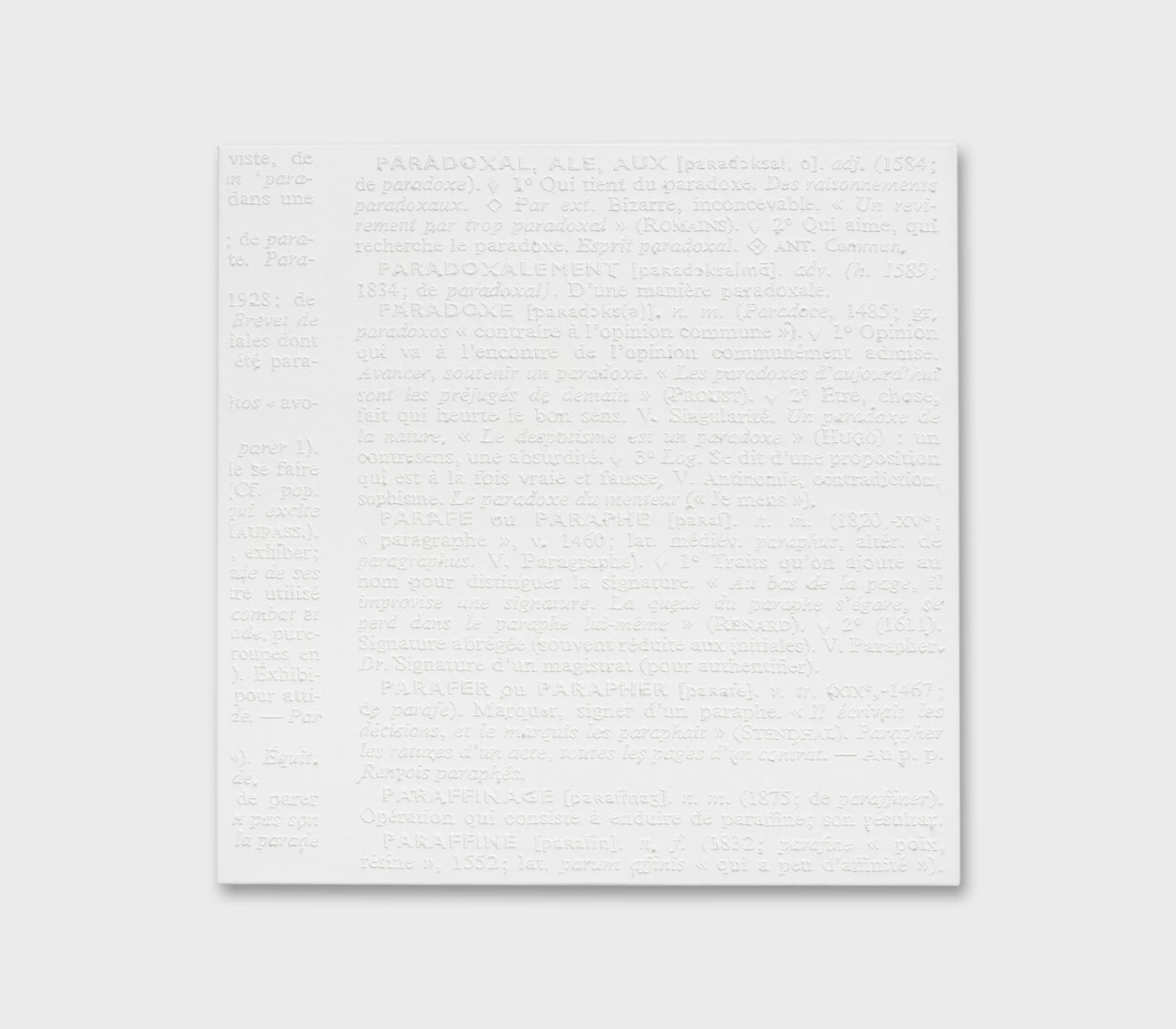Donato Amstutz: Surface Tension 23 October—18 December 2021
Views

|

|

|

|

|
embroidery on canvas, 105 × 105 × 4.5 cm

|
embroidery on canvas, 142 × 142 × 4.5 cm

|
embroidery on canvas, 29.5 × 34 × 4.5 cm

|
embroidery on canvas, 103 × 103 × 4.5 cm

|
embroidery on canvas, recto verso, 23 × 18.5 × 5.5 cm

|
embroidery on canvas, 104 × 104 × 4.5 cm

|
embroidery on canvas, 85 × 85 × 4.5 cm

|
embroidery on canvas, 80 × 80 × 4.5 cm

|
embroidery on canvas, 28.5 × 34 × 4.5 cm

|
embroidery on canvas, 28 × 35 × 4.5 cm

|
embroidery on canvas, 24 × 20 × 4.5 cm
-
Exhibition view
-
Exhibition view
-
Exhibition view
-
Exhibition view
-
Dictionnaire "Paradoxe", 2020
-
Dictionnaire "Incommunicable", 2021
Text
For Amstutz, embroidery involves more than just a perfectly mastered and ancient craft. With its inescapable slowness, his embroidery art stimulates reflection and questioning of a time in which everything is strongly influenced by the fast technologies, the information and communication apparatuses and the concepts of efficiency and optimization. He uses, as he himself calls it, this “banal technique” to step in and out of matter. Expressive, repetitive, and opaque, Amstutz embroiders the black or white thread into perfect, typographic lines.
He skillfully manages the balancing act between split-second photography and the slowness of embroidery, and uses the time to show us things, with irony and silent criticism, in an outsized way that we hardly notice consciously in everyday life. By embroidering objects, enlarging them, and turning them into duplicates, the artist overcomes their banality. The result is an almost dangerous paradox to photography or other graphic productions and techniques.
Covering the surface of a fabric with a multitude of stitches, covering it, decorating it, both burying and exposing it through the regulated play of the distances between these stitches of different sizes, is the work of patience to which Donato Amstutz subjects himself.
It is not a perfect
For Amstutz, embroidery involves more than just a perfectly mastered and ancient craft.
With its inescapable slowness, his embroidery art stimulates reflection and questioning of a time in which everything is strongly influenced by the fast technologies, the information and communication apparatuses and the concepts of efficiency and optimization. He uses, as he himself calls it, this “banal technique” to step in and out of matter. Expressive, repetitive, and opaque, Amstutz embroiders the black or white thread into perfect, typographic lines.
He skillfully manages the balancing act between split-second photography and the slowness of embroidery, and uses the time to show us things, with irony and silent criticism, in an outsized way that we hardly notice consciously in everyday life. By embroidering objects, enlarging them, and turning them into duplicates, the artist overcomes their banality. The result is an almost dangerous paradox to photography or other graphic productions and techniques.
Covering the surface of a fabric with a multitude of stitches, covering it, decorating it, both burying and exposing it through the regulated play of the distances between these stitches of different sizes, is the work of patience to which Donato Amstutz subjects himself.
It is not a perfect image, but the accidental result of a series of changes: a reproduction of a photograph of mediocre quality, sometimes blurred, and subjected to the double process of enlargement.
Through his art, Amstutz achieves that the viewer associates “being” and “reality” through photography and embroidery with “becoming”. Photography and embroidery together, however, make the “transience” in Amstutz’s pictures perceptible. Expressive and at the same time impersonal, the threads and lines maintain a dialogue with the technical reproduction in a perfect mimesis. The contrast between the careful and meticulous execution and the unintentional curiosity with which the viewer recognizes the motifs is emphasized and results in the disproportion between correct habit, banal symbolism, and latent complication.
Donato Amstutz, born in 1969 in Stans, Switzerland, lives and works in Paris and Lucerne. The artist has participated in numerous solo and collective exhibitions in Italy, France, and Switzerland.
